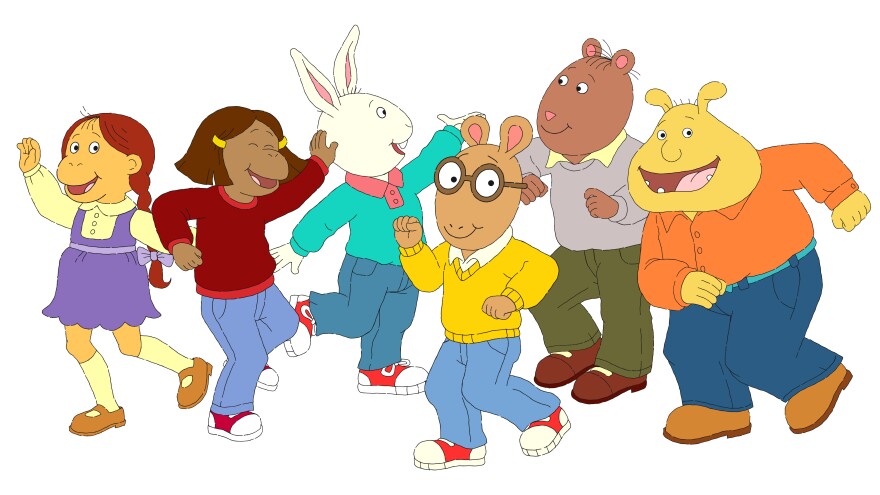Updated February 21, 2022 at 12:56 PM ET
The PBS Kids' TV show Arthur begins its 25th and final season this week. Produced by WGBH, the aardvark (yes, he's an aardvark) will live on in reruns, digital shorts and a podcast — but no new episodes are planned.
Shown in 80 countries, Arthur has won seven Emmy Awards and a Peabody. The books by Marc Brown that inspired the series have sold nearly 70 million copies since the first edition was published in 1976.
To mark the end of an era, Brown looks back on Arthur's legacy in the new book, Believe In Yourself: What We Learned from Arthur.
With his big round glasses, little ears and two dashes for a nose, Arthur looks more like a bespectacled mouse than an aardvark. But he didn't start out that way. In fact, Brown's original drawings of Arthur are more anatomically correct. On the cover of the very first book, Arthur's Nose, he's got a long snout and he doesn't look happy about it.
"I think sometimes that I was rescued by Arthur," Brown says.
In 1976, he was out of a job. "Arthur had a problem with his nose and I had a problem in my life," he recalls. The small Boston college where he was teaching announced it was closing. One night soon after, his son asked him for a bedtime story. Brown asked him what it should be about. His son replied, "a weird animal."
"I don't know why, I must have been thinking alphabetically because aardvarks popped into my head and then he wanted to know his name," Brown says. Thinking alliteratively, Arthur the aardvark was born. Then his son asked him to draw him a picture, "and the thing that stood out for me about aardvarks was their nose ... So this story became about his nose being a problem."
So much of a problem that Arthur considers getting a nose job:
"Arthur tried on all kinds of noses.
Chicken.
Fish.
Elephant
Koala bear."

Marc Brown thought he had a good story on his hands. His publisher did, too. Arthur's Nose was followed by Arthur's Eyes, Arthur's Valentine and 18 more books before the tales launched a TV show — 20 years later.
With its infectious opening theme song, Believe In Yourself, written by Judy Henderson and Jerry DeVilliers Jr. and performed by Ziggy Marley & The Melody Makers, Arthur made its debut on PBS on Oct. 7, 1996.
True to Brown's vision, the menagerie of kids in Elwood City — third-grader Arthur, his often ruthless little sister D.W., Buster, Binky, Francine and the rest quarrel, tease, get in trouble, and fear what they don't understand.
"Our kids are not perfect on Arthur because kids in the world aren't perfect," says Carol Greenwald, who's been the executive producer of the TV series from the beginning. "If they can see other kids on the screen making mistakes and going the wrong way, but then kind of figuring it out and working it out, it's really helpful."
Diverse characters and experiences have been a constant on Arthur. In the first episode, Arthur's Eyes, the titular mammal learns he needs glasses. Francine calls him "four eyes." The other kids laugh, except for Buster. "Some people need glasses to see, Francine. Big deal," he tells her.
For Greenwald, the reaction to Arthur's Eyes was a revelation. "Quickly after it aired, I started getting mail from kids who were blind, saying it's so meaningful for us to see a show about someone wearing glasses," Greenwald remembers. "And I was like, 'Oh my gosh, I mean, if we can reach these kids by just showing somebody wearing glasses, imagine if we had a blind character.' So we created a blind character." Her name is Marina and, through her friendship with Prunella, young viewers learn what it's like to navigate the world with vision loss.

Arthur's writers and producers introduced Carl, a character on the autism spectrum. Binky has food allergies. George has dyslexia. When Buster learned he has asthma, a then-6-year-old viewer named Katerina Daley took notice. "Growing up as a kid with asthma, I had never seen anyone on TV like me in that way before," Daley says.
Today, Daley is a list writer for the website ScreenRant. She also works for The Arc, a nonprofit that helps people with intellectual and developmental disabilities. "I jokingly refer to myself as a disability advocate since kindergarten," she says. Daley combined her interests in the ScreenRant listicle 10 Things From PBS' Arthur That Were Way Ahead of Their Time.
When asked why she became a die-hard Arthur fan, Daley rattles off a long list.
"I loved the characters. I loved the friendship between Arthur and Buster. I loved D.W., the snarky little sister ... I loved seeing parts of myself in all the characters," Daley continues, "I loved how diverse all of the characters were, how every personality was totally different, how every family was different, how everything was all about being yourself and believing in yourself."
But all that diversity has not been universally embraced. In 2019, Alabama Public Television refused to air an episode featuring a same-sex wedding between Arthur's teacher, Mr. Ratburn, and his partner, Patrick. In 2005, funding for the spinoff Postcards from Buster was jeopardized when the titular rabbit met families in Vermont with two moms. At the time, Secretary of Education Margaret Spellings wrote a letter to PBS head Pat Mitchell reminding her that the show received funding from the Department of Education. She added, "Many parents would not want their young children exposed to the life-styles portrayed in this episode."
Today, Spellings acknowledges, times have changed. In a statement to NPR, she writes: "The world is very different today. Every level of government — and every form of media — now reflects a greater openness to the multi-faceted, diverse stories that Americans can tell about themselves, their lives, and the country we share."
Telling children the truth "is the most important thing we've done," says Marc Brown, referring to the hundreds of writers, animators, producers and others who've brought Arthur to life over the decades.
"We, as adults, owe children the truth," Brown says. "They're trying to make a foundation on which they can build their lives, and if there isn't truth in that foundation, things get pretty shaky."
As the last line in Brown's very first book put it more than 45 years ago: "There's a lot more to Arthur than his nose."
The audio and web editions of this story were edited by Meghan Collins Sullivan.
Copyright 2023 NPR. To see more, visit https://www.npr.org.



